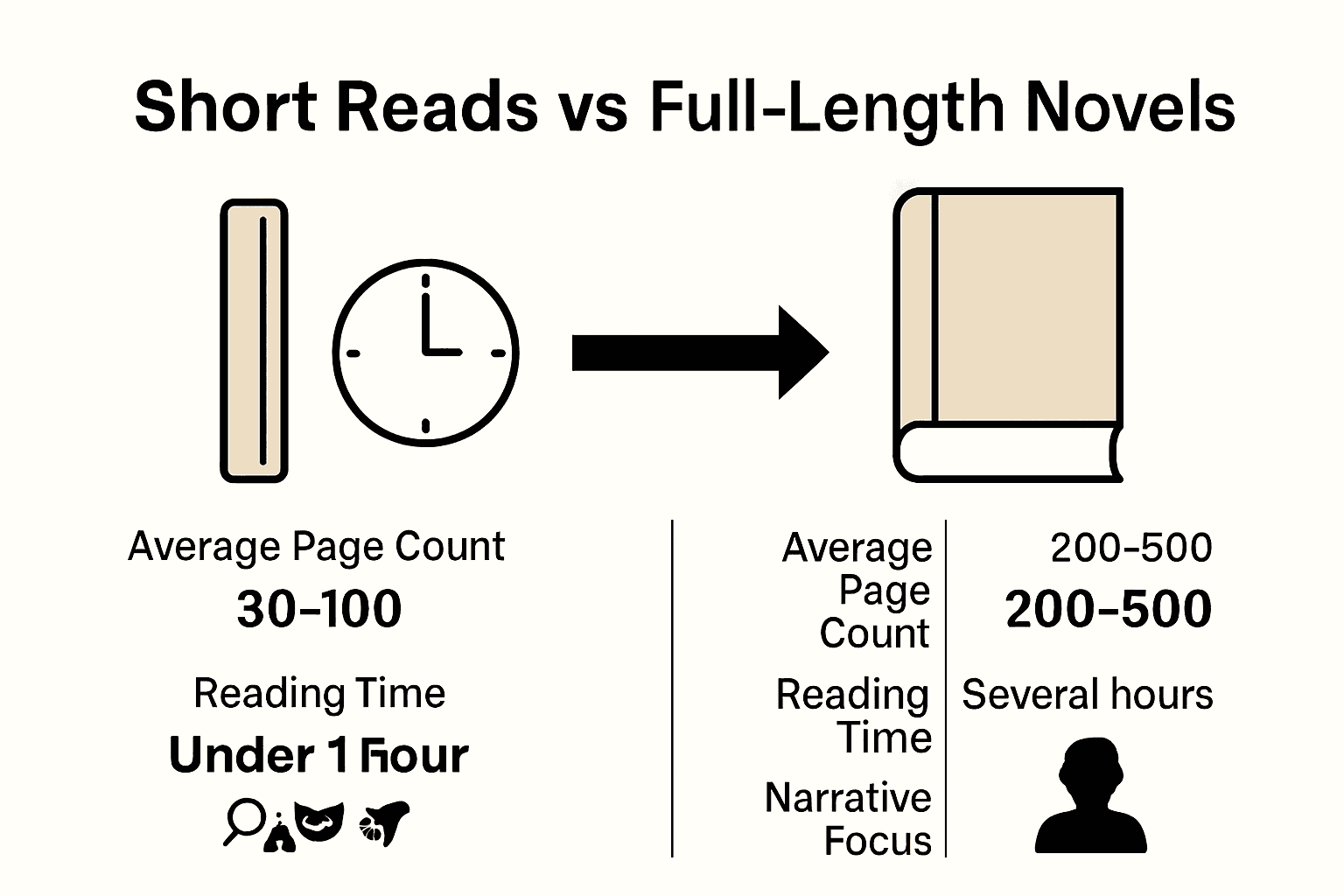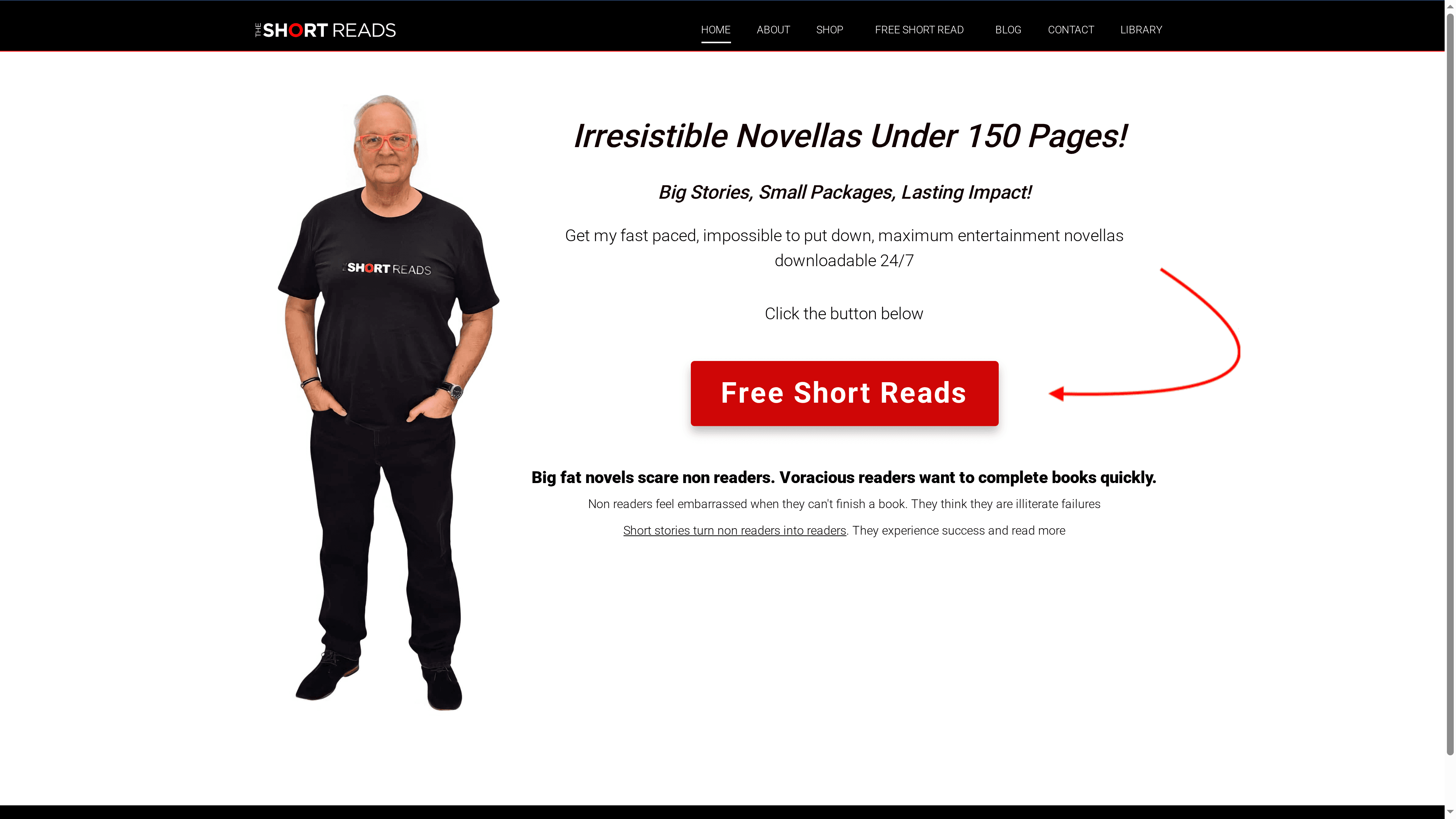Short Reads Benefits: Complete Guide for Busy People

Over half of adults today say they struggle to finish traditional novels due to packed schedules. Short reads have quickly become the preferred choice for people who want quality stories without a big time commitment. With options like novellas and flash fiction, these compact books offer rich narrative experiences you can enjoy while waiting in line or sipping your morning coffee. Discover how short reads fit seamlessly into even the busiest routines and why more readers are making the switch.
Table of Contents
- Defining Short Reads For Busy People
- Types Of Short Reads And Their Appeal
- Key Benefits Of Reading Short Books
- How Short Reads Fit Into Busy Lifestyles
- Comparing Short Reads To Full-Length Novels
Key Takeaways
| Point | Details |
|---|---|
| Short Reads Defined | Compact literary formats tailored for readers with limited time, ranging from 10-100 pages across various genres. |
| Appeal and Accessibility | Ideal for busy individuals, short reads can provide complete narratives in brief intervals, fitting into daily routines. |
| Benefits of Short Reads | They offer time efficiency, reduced reading anxiety, and opportunities for diverse genre exploration while enhancing critical thinking. |
| Comparison with Novels | Short reads allow quick consumption and focused storytelling, while full-length novels offer expansive narratives and deeper character development. |
Defining Short Reads for Busy People
Short reads are compact literary formats designed specifically for readers with limited time and attention spans. Short reads represent concise narrative experiences that deliver engaging content without requiring extensive reading commitments. According to ALA, these literary formats “cater to individuals with limited time by providing concise and engaging material that can be consumed quickly.”
Typically, short reads range between 10-100 pages and include various genres such as:
- Novellas
- Flash fiction
- Short stories
- Serialized content
- Brief standalone narratives
The fundamental purpose of short reads is to provide meaningful storytelling experiences within compressed timeframes. Short-Reads.org highlights this concept perfectly, describing them as “brief yet impactful narratives designed for readers seeking meaningful content without a significant time commitment.”
For busy professionals, parents, commuters, and anyone with limited leisure time, short reads offer an accessible alternative to traditional lengthy novels. These condensed literary experiences allow readers to enjoy complete narratives during short breaks, morning commutes, or brief moments of personal downtime. Discover our comprehensive guide on the benefits of short reads to understand how these compact stories can transform your reading habits.
Types of Short Reads and Their Appeal
Short reads represent a diverse literary landscape, offering multiple formats to suit different reading preferences and time constraints. According to ALA, these reading formats “include serialized content, brief standalone pieces, and text message-style narratives, appealing to readers by offering concise and engaging material that fits into limited time frames.”
The primary types of short reads include:
- Novellas: 50-100 pages, deeper narrative complexity
- Short Stories: Typically 10-50 pages, focused single narrative arc
- Flash Fiction: Ultra-compact stories under 1,000 words
- Serialized Narratives: Episodic content released in installments
- Micro-Essays: Brief non-fiction pieces exploring specific topics
Scholastic emphasizes that these formats are particularly valuable for educational contexts, providing “levelled, short informative and persuasive texts across various types and contexts.” This versatility makes short reads appealing to diverse audiences, from students to busy professionals seeking quick, meaningful reading experiences.
Each short read format offers unique storytelling advantages. Novellas provide more character development than short stories, while flash fiction challenges writers to convey complex emotions in minimal space.
Explore our comprehensive guide on novellas to understand how these compact narratives can deliver rich, immersive experiences without demanding extensive time commitments.
Key Benefits of Reading Short Books
Short books offer a transformative reading experience tailored for modern lifestyles. According to ALA, these reading formats “encourage reading among those pressed for time, reluctant to read, or distracted by technology, by providing concise and engaging material that can be consumed quickly.”
The key benefits of reading short books include:
- Time Efficiency: Complete a full narrative in a single sitting
- Skill Building: Improve reading comprehension and focus
- Reduced Reading Anxiety: Less intimidating than lengthy novels
- Diverse Exploration: Discover multiple genres and writing styles
- Mental Stimulation: Engage with complex ideas in compact formats
Scholastic emphasizes that short reads are particularly powerful for developing critical thinking, noting they are “designed for close reading and deep comprehension, helping build vocabulary and critical thinking skills through careful study of short text passages.”
Reading short books can be a strategic approach to maintaining an active reading habit. They accommodate busy schedules, reduce commitment barriers, and provide rich storytelling experiences without overwhelming readers.
 Explore our comprehensive guide comparing short reads and full novels to understand how these compact narratives can revolutionize your reading journey.
Explore our comprehensive guide comparing short reads and full novels to understand how these compact narratives can revolutionize your reading journey.
How Short Reads Fit Into Busy Lifestyles
Modern lifestyles demand flexible reading solutions that accommodate limited time and constant interruptions. According to ALA, short reading formats “cater to individuals with limited time by providing concise and engaging material that can be consumed quickly.”
Strategic reading moments for busy people include:
- Morning Coffee Break: Quick 15-20 minute reading session
- Commute Companion: Perfect for subway or bus travel
- Lunch Break Entertainment: Digestible narratives during midday rest
- Before Bed Wind-Down: Short stories to relax without long commitments
- Weekend Micro-Reading: Fitting complete narratives into small windows
Short-Reads.org reinforces this approach, highlighting how these formats offer “brief yet impactful narratives designed for readers seeking meaningful content without a significant time commitment.” These compact reading experiences transform seemingly unproductive moments into opportunities for mental stimulation and storytelling engagement.
The beauty of short reads lies in their adaptability to unpredictable schedules. Whether you have 10 minutes or an hour, these literary formats ensure you can always find a narrative that fits your available time. Check out our guide to short reads for commuters to discover how to maximize your reading potential in the most unexpected moments.
Comparing Short Reads to Full-Length Novels
Reading experiences vary dramatically between short reads and full-length novels, each offering unique advantages for different reader preferences. According to ALA, short reading formats “provide concise and engaging material that can be consumed quickly, catering to individuals with limited time, whereas full-length novels require a more substantial time commitment.”
Key differences between short reads and full-length novels include:
- Time Investment: Short reads (10-100 pages) vs novels (300-800 pages)
- Narrative Complexity: Focused storylines vs expansive plot development
- Reading Accessibility: Quick consumption vs extended reading sessions
- Character Development: Concentrated character arcs vs detailed character exploration
- Genre Flexibility: Multiple genre experiences vs deep genre immersion
Scholastic emphasizes that short reads are “designed for close reading and deep comprehension,” allowing readers to build critical thinking skills through carefully structured narratives. This approach contrasts with full-length novels, which offer broader but less intensely focused storytelling experiences.

Ultimately, both formats have their place in a reader’s literary journey. Short reads provide rapid narrative satisfaction, while novels offer more comprehensive storytelling. Explore our comprehensive guide to understanding the differences between novels and short reads to determine which format best suits your reading style and time constraints.
Discover the Power of Short Reads for Your Busy Life
Feeling overwhelmed by long books but craving captivating stories that fit your hectic schedule The article highlights how short reads solve this by offering compact, meaningful narratives that you can enjoy anytime without anxiety or heavy time commitment. Whether you want to escape with cozy mystery short reads or dive into intense psychological thriller short reads these formats provide a perfect balance of depth and brevity.
Unlock moments of relaxation and mental stimulation even during your busiest days by exploring our curated selection of murder mystery novellas and action thriller novellas all designed to fit your limited time perfectly.

Elevate your reading experience now with stories that match your lifestyle Stop putting off reading because of time constraints Visit theShortReads.com today and start your journey through thrilling and engaging short reads made for busy people like you.
Frequently Asked Questions
What are short reads?
Short reads are compact literary formats ranging from 10-100 pages, designed for readers with limited time. They include genres such as novellas, short stories, flash fiction, and serialized content, providing engaging narratives without extensive reading commitments.
What are the benefits of reading short books?
Reading short books enhances time efficiency, reduces reading anxiety, encourages skill building, supports diverse exploration of genres, and provides mental stimulation. They allow readers to complete a full narrative in one sitting and improve reading comprehension skills.
How can short reads fit into a busy lifestyle?
Short reads can easily integrate into busy lifestyles. They are perfect for quick reading sessions during morning coffee, commutes, lunch breaks, ahead of bed, or even short weekend breaks, turning unproductive moments into opportunities for storytelling.
What are the differences between short reads and full-length novels?
Short reads require considerably less time to complete than full-length novels and offer focused storylines. While short reads provide quick narrative satisfaction, novels allow for extensive character development and deeper immersion in complex plots.
Recommended
- Understanding the Benefits of Short Reads – TheShortReads.com
- Short Reads vs Full Novels: Complete Guide – TheShortReads.com
- Understanding Why Concise Summaries Help Communication
- Summarizer Specialist – My Framer Site
